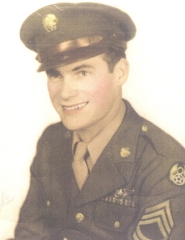Owen T. Brennan

Owen T. Brennan
OWEN
T.
BRENNAN
SOLDIER DETAILS
BIOGRAPHY
Owen T. Brennan was born on 9 Nov 1922 in St. Louis, MO. He graduated from high school the summer of 1942 and apprenticed as a painter. On 29 Dec 1942 he was inducted in the Army at Jefferson Barracks, St. Louis, MO, was assigned to the Army Air Corps, and sent across the Mississippi River to Scott Army Air Base to attend Radio School. Upon completion, he attended Gunnery School in Harlingen, TX. By Nov 1943, he was a radio operator gunner on a B-24 Liberator in Casper, WY training for overseas combat. Within the month, they were informed they would be assigned to a new bomb group being formed, the 467th bomb group commanded by Col. Albert Showers with training at Wendover Army Air Base, UT. In Jan 1944, they were on the way to the European Theater. They picked up a new B-24 bomber in Topeka, KS and named it 'The Royal Flush.' Crossing the Atlantic from Trinidad, South America, to Dakar, Marrakech, Africa and on to Wales, England, they arrived on 9 Mar 1944. After landing in England, they had their B-24 taken from them and took the train to their home base at Rockheath, Norwich, East Anglia, England. Their crew was George Perry, Pilot; Vic Lentz, Co-pilot; Vern Bleck, Bombardier; Homer Dippold, Navigator; Gene Bateman, Engineer; Owen, Radio Operator; Alex Duncan and John Krajny, Waist Gunners; Tom LaGary, Tail Gunner; and Gerry Melton, Ball Turret Gunner. Their bomber, #373 'C' was named Monster. The nose art was a dragon with two machine guns sticking out of its nose. Their mission was 4 hours to and 4 hours back and they lost one bomber. The next mission was to Hamm, where Owen lost a good friend, George Carter from Chicago who was on another bomber. Owen completed 35 missions with each one of different exposures. He was concerned 'how would he react, would he do his job correctly, would he show fear.' Each mission was hours of boredom interrupted by moments of sheer terror! He does not remember what happened on some of his missions, but still remembers the one on the first part of May 1944. It was to the Herman Goering Steel Plant near Brunswick, Germany. Lots of fighters hit them and they lost 15 to 20 bombers that day. As the fighters started their run, he remembers the Pilot, Rod McKay, saying 'Boys, give your hearts to God because Hitler's got your a**.' He remembers one fighter starting his run at them and firing about 1000 yards away. His 20mm shells burst in the air before they reached them. He opened fire at him when he was about 500 yards away and as the distance closed, he thought he was going to ram them. At about 200 yards, he forgot about firing short bursts and fired point blank, holding the trigger down. He knew he hit him as the tracers were bouncing off the armor plate. His guns stopped firing and he passed about 30 feet over the top of the formation. All this time, Owen's knees were shaking. They lost one engine on the way back to base; they had been hit by three 20mm shells and had over 100 holes in their aircraft. They, along with three others could not keep up with the formation. They and one other plane made it back while another had gone down. After completion of his required missions, he was sent to France at the forward airfields as a ground radio operator. Owen returned to the USA on 2 Nov 1944. After 30 days leave, he reported to replacement pool for crewman for the B-29 Bomber at a West Coast Army Air Force Base. The Sergeant Major interviewing him for reassignment was impressed that in the nine months he had served in the European Theater of Operations, he had completed 35 combat missions and served on the ground in France. He said as far as he was concerned that Owen had already done his service in the war and no way was he going to assign him to a B-29 crew. He graciously sent him to a C-54 Logistic crew that was delivering materials to the Islands in the Asiatic Pacific Theater of Operations. He served there until his discharge on 24 Oct 1945 at Truax Fie
 Eisenhower Foundation
Eisenhower Foundation
